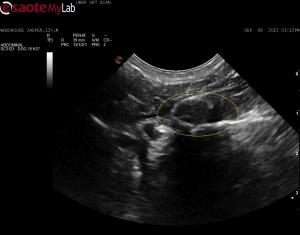– 12 yr old FS Wheaten Terrier presented for a fairly acute onset of front R lameness and knuckling
– neck appears painful with head down posture and resents dorsal flexion of the neck
– dehydrated on presentation CBC/biochem unremarkable other than elevated ALT 400’s (was previously noted to be 600’s a few months ago so not new finding)
– spondylosis noted in thoracic vertebrae otherwise x-rays of spine and shoulder joints unremarkable
– liver is diffusely hyperechoic on ultrasound (DDX: CAH, vacuolar or steroid hepatopathy, neoplasia); biopsy needed
– 12 yr old FS Wheaten Terrier presented for a fairly acute onset of front R lameness and knuckling
– neck appears painful with head down posture and resents dorsal flexion of the neck
– dehydrated on presentation CBC/biochem unremarkable other than elevated ALT 400’s (was previously noted to be 600’s a few months ago so not new finding)
– spondylosis noted in thoracic vertebrae otherwise x-rays of spine and shoulder joints unremarkable
– liver is diffusely hyperechoic on ultrasound (DDX: CAH, vacuolar or steroid hepatopathy, neoplasia); biopsy needed
– u/s of the shoulders performed looking for a possible nerve sheath tumour around the brachial plexus
1. In the first clip, have I identified the brachial plexus? Normal looking?
2. In the other clips and the still I identified a roughly oval structure in the armpit region with the probe sag to patient that has a mineral opacity in it. No colour flow. When rotating the probe it elongates with a linear hyperechoic opacity running through it. I found this structure on both sides so it is likely not pathogenic. Any idea what it is? Biceps tendon? I have very limited experience scanning this region.
Advanced imaging has been recommended for this patient.

Comments
Yes the first clip covers
Yes the first clip covers part of the brachial vascular and nerve plexus. Actually there are a number of positions that can be scanned from the neuroforaminal exit zone next to the cervical vertebrae to the first rib, the region medial to the shoulder joint and the axillary region. For the axiallary region: Use the deepest dip caudal to the pectoral muscle (palpable as a string) as your window. Angle the probe slightly more towards the chest not towards the limb. Then try to sweep through the axillary region mediad & laterad as well as craniad & caudad aiming to cover as much ground as possible.
Dont forget to check the axillary lymph nodes.
What I see in clip 1 looks normal.
The nerves are smaller than the accompanying vessels and usually not wider than 3mm in large dogs.
I would recommend to use Doppler to differentiate vessels from nerves when in doubt – whenever possible prefer power Doppler here since it is not angle dependent. With perpendicular insonation of a vessel and Color Doppler you get signal drop out in the vessel and might mistake this for a thickened nerve.
The remainder of the clips indeed shows normal anatomy. It is the costochondral junction of a rib.
Hope this helps;)
Very helpful! Thank-you Dr.
Very helpful! Thank-you Dr. Ondreka.
From the history and normal
From the history and normal brachial plexus, cervical spine tumor would be an important consideration with focal GME also possible. Would need an MRI.
We were thinking of some sort
We were thinking of some sort of cervical spinal pathology as well Remo including IVDD. Owners have declined advanced imaging unfortunatley at this stage so we are managing the pain with tramadol and Metacam (although not the best with suspected liver pathology). I guess time will tell with this one.
if anyone is interedsted in
if anyone is interedsted in our next orthopedic and small parts US course just email us at info@sonopath.com.
It will be stateside in the late spring 2016 likely. Will do it earlier if we have adequate interest. Dr. Ondreka does this course and it will be stateside. We cover shoulder, stifle, achilles, brachial plexus, muscles/tendond in general, thyroid/parathyroid, eys, ears and other.
Eric, please keep me in the
Eric, please keep me in the loop for this. I would be interested in a formal course on joints and ortho conditions.